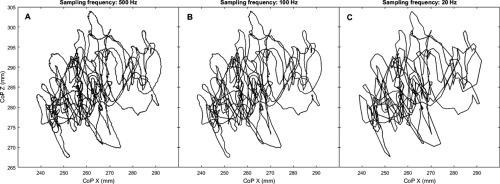IRBM ( IF 5.6 ) Pub Date : 2020-08-12 , DOI: 10.1016/j.irbm.2020.08.001 M. Freddolini , A. Corvi , L. Barni , F. Esposito

|
Purpose
to evaluate how different data sampling and different analysis methods may effect numerical results and interpretation of single leg stance test using parameters derived from CoP trajectories.
Methods
Thirty healthy active subjects were recruited for this study on voluntary. Each participant was asked to stand as still as possible for 20 s on the dominant limb, with the supporting foot placed on the force platform. Balancing task in two conditions, with eyes open (EO) and closed (EC). Three trials were collected for each condition.
Medial-lateral and anterior-posterior CoP force platform data were obtained and downsampling techniques was applied to get data at original (500 Hz), 100 Hz and 20 Hz of sampling frequencies.
Time series data were then analysed to get CoP variables including medial-lateral total path, anterior-posterior total path, total path, maximal excursion for the ML plane and maximal excursion for the AP plane. Sway area was evaluated as 95% confidence ellipse area (CEA) and as 95% prediction ellipse area (PEA)
Main findings
Significant different results were obtained for the same variable evaluated at different sampling frequency. In addition, at all sampling frequencies variables were significantly different (p.<0.05) between EO and EC conditions. High correlation (>0.9) between the same CoP variable calculated at different sampling frequencies was found for all CoP variables. Regarding sway area calculation, both methods were able to distinguish between EO and EC conditions and high correlation was found between CEA and PEA methods.
Conclusion
Overall results of this study demonstrated the importance of reporting data processing techniques, which includes sampling frequency and variable calculation methods, as they shown to influence one leg stance CoP results, thus data analysed in different manner cannot be directly compared. However, for the variables included in the study, researchers can choose preferred data collection and data analysis methods as they all return same data analysis interpretation as long as they keep consistency in the method.
中文翻译:

数据处理技术可能会影响数值结果和单腿姿态测试的解释
目的
评估不同的数据采样和不同的分析方法如何影响数值结果以及使用从CoP轨迹得出的参数对单腿站姿测试的解释。
方法
自愿招募了30名健康活跃受试者参加本研究。要求每个参与者在支腿上尽可能静止不动地站立20 s,将支撑脚放在力平台上。在两种情况下平衡任务,即睁眼(EO)和闭眼(EC)。针对每种情况收集了三个试验。
获得内侧-外侧和前后CoP力平台数据,并应用降采样技术获取原始(500 Hz),100 Hz和20 Hz采样频率的数据。
然后分析时间序列数据以获取CoP变量,包括内侧-外侧总路径,前后总路径,总路径,ML平面的最大偏移和AP平面的最大偏移。摇摆面积评估为95%置信椭圆面积(CEA)和95%预测椭圆面积(PEA)
主要发现
对于在不同采样频率下评估的同一变量,获得了明显的不同结果。此外,在所有采样频率下,EO和EC条件之间的变量均存在显着差异(p。<0.05)。对于所有CoP变量,发现在不同采样频率下计算出的同一CoP变量之间具有高度相关性(> 0.9)。关于摇摆面积的计算,两种方法都能够区分EO和EC条件,并且在CEA和PEA方法之间发现高度相关。
结论
这项研究的总体结果证明了报告数据处理技术的重要性,其中包括采样频率和变量计算方法,因为它们显示出会影响单腿CoP结果,因此无法直接比较以不同方式分析的数据。但是,对于研究中包含的变量,研究人员可以选择首选的数据收集和数据分析方法,因为只要它们保持一致,它们都将返回相同的数据分析解释。











































 京公网安备 11010802027423号
京公网安备 11010802027423号